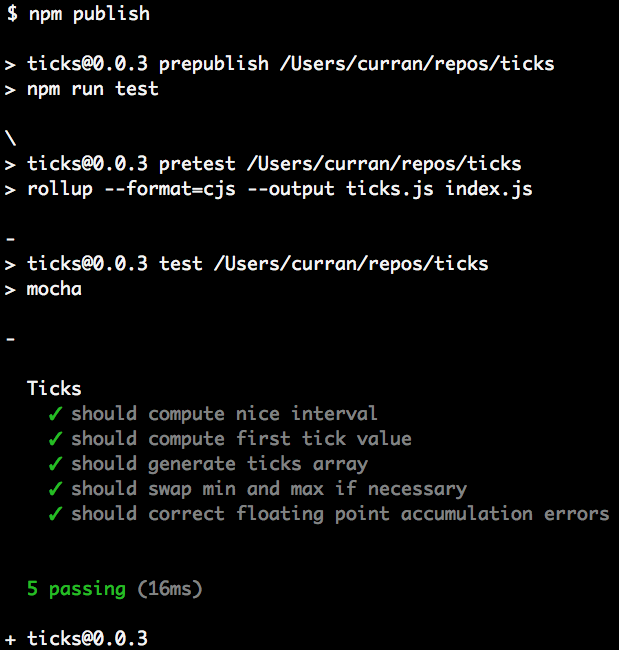Ticks
A utility for choosing nice tick marks or histogram intervals.
API
ticks(min, max, n)
minThe minimum value of the interval.maxThe maximum value of the interval.nThe approximate number of desired ticks.
Returns an array of "ticks", numbers that are suitable to use as tick mark values. The first tick will be less than or equal to min, and the last tick will be greater than or equal to max.
Usage
Install via NPM:
npm install -S ticks
Example use:
var ticks = ; ; //[ 0, 1, 2, 3, 4, 5, 6, 7, 8, 9, 10 ]; // [ 0, 2000, 4000, 6000, 8000, 10000 ]; // [-1,-0.8,-0.6,-0.4,-0.2,0,0.2,0.4,0.6,0.8,1]; //[1000,1000.2,1000.4,1000.6,1000.8,1001,1001.2,1001.4,1001.6,1001.8,1002]API
# ticks(min, max, numTicks [,tight])
Computes and returns approximately numTicks ticks spaced nicely that include the intervaj [min, max].
If tight is specified, then the first tick is the min, and the last tick is the max. The The Graphics Gems chapter "Nice Numbers for Graph Labels" by Paul S. Heckbert introduces the notion of "loose" and "tight" tick marks.
Algorithm
The algorithm for computing ticks is based on the idea of a "nice interval". Nice intervals can be expressed as (base * 10^exp), where exp is some integer exponent, and base is either 1, 2, or 5. Examples of nice intervals are 0.1, 0.5, 10, 20, 5, 2, and 500.
The Ticks algorithm computes the exponent of the raw interval, by Math.log10((max - min) / n), then computes both the floor and ceiling of this value, which are candidate exponents for use in generating nice intervals. The algorithm then tries all 6 possible combinations of the two candidate exponents with the possible bases (1, 2, and 5) to generate a set of candidate nice intervals. From the generated set of nice intervals, the one that is closest to the raw interval ((max - min) / n) is chosen.
Related Work
The seminal approach for generating tick marks appeared in "Nice Numbers for Graph Labels" by Paul S. Heckbert in the book "Graphics Gems", originally published in 1990.
Subsequently, there have been a variety of new takes on the problem. This research paper presents an approach for this that takes more factors into account, including the actual size of label text: An Extension of Wilkinson’s Algorithm for Positioning Tick Labels on Axes, by Justin Talbot, Sharon Lin, and Pat Hanrahan, and also surveys other algorithms.
Also, a similar algorithm is implemented in D3.scale.linear.ticks.
Development Tooling
This module is published as an NPM package. The module itself is authored using ES6 module syntax in index.js, which is declared as the jsnext:main entry point in package.json so it can be included in Rollup-based builds. The module is converted to CommonJS format in the prepublish script, which runs the pretest and test scripts, making the built fileticks.jsavailable in the NPM package. The built file is excluded from the Git repository via the.gitignorefile. Usually NPM ignores files in.gitignore, so to cause NPM to includeticks.js, an [empty.npmignore` file was added.
Here's what it looks like when npm publish is run:

During development you can run npm test to run the Rollup build and run the unit tests. The Mocha unit tests are written in ES5, and consume the CommonJS package generated by Rollup via Node.js.
Curran Kelleher June 2015